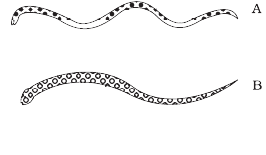Class 6 Science NCERT Exemplar Solutions Chapter 8 Body Movement
FAQs on NCERT Exemplar for Class 6 Science Solutions Chapter 8 Body Movement
1. Is it important to study Chapter 8 of NCERT Solutions for Class 6 Science for the exams?
Yes, absolutely!
2. What all topics will I learn from Chapter 8 of NCERT Solutions for Class 6 Science?
Chapter 8 of Class 6 Science includes some very important topics that will make you understand the many movements our bodies are capable of.
Important Topics:
The human body and its movements
Ball and socket joints
Pivotal Joint
Hinge joints
Fixed joints
Gait of animals – Earthworm, snail, cockroach, fish, birds
How do snakes move?
These topics are thoroughly explained in Chapter 8 of NCERT Solutions for Class 6 Science. Towards the end, there are important keywords mentioned along with a summary of all that is given.
3. Why is it suggested to refer to the NCERT Solutions for Class 6 Science Chapter 8?
Some of the main reasons for referring to NCERT Solutions for Class 6 Science Chapter 8 are –
1. All the textbook topics and questions are given in a well descriptive manner.
2. These solutions will allow you to solve complicated questions easily if you study well and revise on time.
3. Through regular practice, you can develop tools to divide your time between questions and note down your areas of weakness and work on them for a better score.
4. It will help you better understand the type of questions asked and develop a familiarity with the examination patterns.
5. Reading these solutions will help enhance your self-confidence if you study and analyze your strengths and weaknesses and work upon them rigorously.
6. Diagrams and activities are given for each topic to help you learn them easily.
4. How important is it to solve all the exercises in this Chapter 8 of NCERT Solutions for Class 6 Science?
It is always recommended to solve all the exercises in Chapter 8 of NCERT Solutions for Class 6 Science so you are well prepared for your exams with full confidence. Although Science is a theoretical subject, one cannot understand these complex concepts by simply reading or memorizing them. It requires hard work, diligence, and practice. NCERT Solutions for Class 6 Science of this Chapter has solutions to all exercises. After going through each topic from your book, you can go through the solved examples in these solutions and understand them thoroughly to solve them with complete ease.This will help you with the exam fear by making you familiar with the topics with you revise the topics well.
5. How do I score well in Class 6 Science?
Revising, Reading and Revisiting topics is the only way to score well in Class 6 Science. Using these solutions you get answers to all the chapter exercises that will help you understand the topics better, improve your problem-solving ability, and better your speed and efficiency. Use these solutions to solve the exercises within a time limit to improve your speed. This will not only get you familiar with the paper pattern, question type but also improve your time management in exams. Revise these solutions timely for better retention of these topics!



















